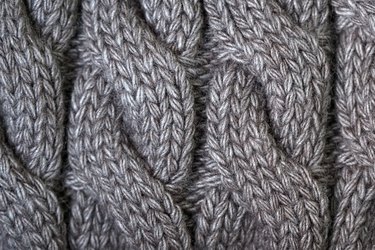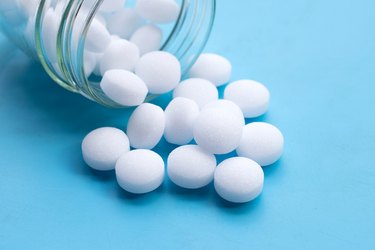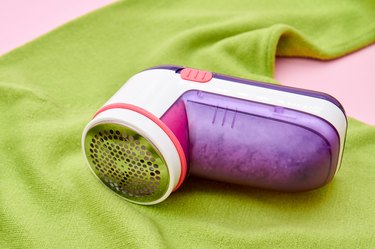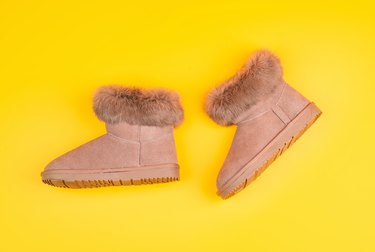
No matter your feelings about cold weather, we can all agree that "sweater season" has its merits. As fall turns into winter, we get to spend a few months living in our comfiest clothes. But once you move all those cozy fleece PJs, flannel plaid shirts and chunky sweaters into the daily rotation, you'll inevitably face a few minor wardrobe malfunctions. Blame the combination of cold, wet weather and the unique challenges of warm fabrics such as wool and fleece.
This year, don't toss that "ruined" sweater back into the closet. We've rounded up five of the most common winter clothing problems that might plague you before spring—plus easy DIY solutions to help you keep your favorite pieces in prime condition.
Video of the Day
Video of the Day
Here are some common clothing laments and how to fix them:
1. "My winter clothes have set-in stains from last season!"

THE PROBLEM: Remember when you packed up your winter clothes last spring and thought, "Eh, I'll deal with these stains next year?" Well, it's next year. Depending on the fabric and the nature of the stain, though, it might be possible to lift set-in stains.
THE SOLUTION: Attempt stain removal or move straight into stain disguise mode. Some stained clothing can be soaked in a solution with disinfecting bleach, but fabrics like wool, silk and leather shouldn't be cleaned this way. Stains in silk fabric can sometimes be erased using a solution of equal parts water and lemon juice or vinegar. (Still, don't forget to do a spot test somewhere inconspicuous before attacking the stain.) Obviously, a dry cleaner should be able to help with really tricky or delicate fabrics.
2. "I keep getting burrs stuck in my clothes!"

THE PROBLEM: There's something deeply peaceful about taking a quiet walk through the wilderness on a crisp winter's day...unless you come home with clothes covered in burrs. There are different types of burrs (sometimes spelled as burs or also called stickers), but they're essentially little seeds covered in hooks; hence the way these tiny hitchhikers cling to your clothing like Velcro. But that's no reason to stay indoors!
THE SOLUTION: There are a few strategies for getting burrs off fabric that are much quicker than picking them out one by one with a pair of tweezers or pliers:
- Wrap a piece of duct tape around your hand, sticky side out. Press tape into the fabric and use a rolling motion to pull up the burrs.
- Lay the garment on a flat surface. Using one hand to hold fabric taut, use a fine-tooth comb or metallic comb to gently scrape off burrs.
- Invest in a tool that's designed to remove burrs. There's one called the Burr Paw that's designed to pull burrs off fabric and animal fur. (Just don't rush to hit "buy" on the first product you find described as a "burr removal tool" or you might end up with a tool that's designed for metal workers!)
3. "My clothes smell like mothballs!"

THE PROBLEM: Maybe you're determined to rock your mom's '90s sweaters this winter, but they've been in storage for, well, decades. Or you've scored some cute vintage winter wear from an online seller and it arrives smelling musty. Banishing the stubborn odor of mothballs is a must-do before showing off your haul.
THE SOLUTION: Air them out, then try a special wash. Airing out musty clothes for a few days may knock down at least some of that funky smell. If possible, hang them somewhere where they'll be exposed to a breeze and sunlight, such as on a clothesline outdoors, in a drafty garage or in a screened porch. You might want to wear gloves, as mothball chemicals can cause skin irritation. Be especially mindful to keep them out of areas that pets and kids have access to—mothball chemicals can be hazardous, and you wouldn't want any curious little mouths munching on that fabric before it's washed!
Next, give mothball-scented clothes an odor-neutralizing bath. Follow care instructions to determine which water temperature is best and whether pieces can be machine-washed; when in doubt, stick to cool water and hand-washing versus hot water and the washer. The standard advice is to add a cup or so of vinegar to the wash cycle, but consider experimenting with cleansing agents such as baking soda and castile soap for super-musty garments or vintage pieces.
4. "My sweaters are pill magnets!"

THE PROBLEM: Pilling is basically inevitable for certain woven fabrics, such as wool and cotton. Over time, friction causes fibers to break and tangle into those tiny balls. You can't really stop them from forming, though hand-washing things that tend to pill will at least protect them from all the friction created in the washing machine.
THE SOLUTION: Give 'em a close shave! Removing pills as they pop up is your best option. Lay fabric flat on a table and use a disposable razor or pumice stone to gently scrape pills away. Alternatively, invest in a fabric shaver so you always have a quick and easy way to banish a lot of those little pests at once.
Want More Clothing Rescue Tips?
Bless the good people of TikTok, who are always there when you need a brilliant laundry hack or ideas for upcycling! Some accounts you might want to follow:
- @melissadilkespateras: a "Laundrytok" legend who answers questions about all things laundry, cleaning and general DIY.
- @second.life.studio: your go-to source for tutorials on mending, upcycling and repairing damaged clothing.
- @tammy.silver: fashionista offering step-by-step sewing tutorials and general sewing tips you might need to fix or tailor your winter clothes.
5. "My shoes are getting ruined by salt stains!"

THE PROBLEM: Anyone who lives somewhere snowy knows that road salt is both a blessing and a curse. Sure, it might help you avoid sliding around when conditions are slippery, but it's hard to be grateful when your shoes are crusted with a white salty haze.
THE SOLUTION: Water and white vinegar to the rescue! The key to removing salt stains from shoes and boots is to act quickly. As soon as you take them off, wipe away any salty, slushy residue with a dry cloth. Dampen a cloth with a solution of water and vinegar, and wipe down shoes. It should be safe for most shoe types, including leather. Some people use equal parts water and vinegar, but if you're worried about damaging your shoes with vinegar, start with a weaker solution and add more vinegar after you're confident that you're not causing damage.
Tip
Using an eraser might also lighten or remove salt stains from shoes! Check out the TikTok video of this method that @cleanthatup shared to clean up a pair of boots.
With these five top tips for clothing maintenance, you can focus on being comfy, cozy and fashionable during the chilly months. May all your favorite sweaters be clean, pill-free and great-smelling all season long!